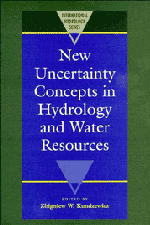Book contents
- Frontmatter
- Contents
- List of Authors
- Preface
- I INTRODUCTION
- II FACETS OF UNCERTAINTY
- III NOVEL APPROACHES TO UNCERTAINTY: FRACTALS, FUZZY SETS AND PATTERN RECOGNITION, NON-PARAMETRIC METHODS
- 1 Dispersion in stratified soils with fractal permeability distribution
- 2 Multifractals and rain
- 3 Is rain fractal?
- 4 Multifractal structure of rainfall occurrence in West Africa
- 5 Analysis of high-resolution rainfall data
- 6 Application of fuzzy theory to snowmelt runoff
- 7 On the value of fuzzy concepts in hydrology and water resources management
- 8 Application of neural network in groundwater remediation under conditions of uncertainty
- 9 Application of pattern recognition to rainfall–runoff analysis
- 10 Nonparametric estimation of multivariate density and nonparametric regression
- 11 Nonparametric approach to design flood estimation with pre-gauging data and information
- IV RANDOM FIELDS
- V TIME SERIES AND STOCHASTIC PROCESSES
- VI RISK, RELIABILITY AND RELATED CRITERIA
5 - Analysis of high-resolution rainfall data
Published online by Cambridge University Press: 07 May 2010
- Frontmatter
- Contents
- List of Authors
- Preface
- I INTRODUCTION
- II FACETS OF UNCERTAINTY
- III NOVEL APPROACHES TO UNCERTAINTY: FRACTALS, FUZZY SETS AND PATTERN RECOGNITION, NON-PARAMETRIC METHODS
- 1 Dispersion in stratified soils with fractal permeability distribution
- 2 Multifractals and rain
- 3 Is rain fractal?
- 4 Multifractal structure of rainfall occurrence in West Africa
- 5 Analysis of high-resolution rainfall data
- 6 Application of fuzzy theory to snowmelt runoff
- 7 On the value of fuzzy concepts in hydrology and water resources management
- 8 Application of neural network in groundwater remediation under conditions of uncertainty
- 9 Application of pattern recognition to rainfall–runoff analysis
- 10 Nonparametric estimation of multivariate density and nonparametric regression
- 11 Nonparametric approach to design flood estimation with pre-gauging data and information
- IV RANDOM FIELDS
- V TIME SERIES AND STOCHASTIC PROCESSES
- VI RISK, RELIABILITY AND RELATED CRITERIA
Summary
ABSTRACT Point-rainfall data recorded by a fast-responding optical raingauge were analyzed. The methods used range from statistical analysis to the fractal and chaotic dynamics approaches. The study showed the evidence of scaling and chaotic dynamics. It is believed that the insight into the dynamics of rainfall data with very fine increment, gained in the course of the exercise, could be useful in advancing our capability to reliably estimate probable maximum rainfall for design purposes.
INTRODUCTION AND BACKGROUND
The realization that it is possible to have a temporal natural process that has a random appearance but which is generated by a deterministic set of ordinary differential equations, triggered by Lorenz (1963) in his now well known example of the dynamics of a convecting fluid, has initiated a wealth of attempts to re-investigate natural phenomena thought to be inherently random. Rainfall rate is one such natural variable and a few investigations of its nature and dynamics have already appeared in the literature that provide some evidence for the existence of a deterministic generating mechanism in the rainfall process at small spatial scales (Rodriguez-Iturbe et al, 1989, and Sharifi et al, 1990). The mathematical methods for the investigation of this ‘new’ dynamics (called chaotic dynamics) require samples with very fine temporal resolution, that goes beyond the resolution available with conventional in situ raingauges. The work presented herein reports results obtained using very-fine increment convective-rainfall data recorded by a specially-calibrated optical raingauge in Iowa City, Iowa, USA, during the summer of 1989.
- Type
- Chapter
- Information
- New Uncertainty Concepts in Hydrology and Water Resources , pp. 114 - 120Publisher: Cambridge University PressPrint publication year: 1995
- 5
- Cited by

